Qianru Sun
3D Question Answering via only 2D Vision-Language Models
May 28, 2025Abstract:Large vision-language models (LVLMs) have significantly advanced numerous fields. In this work, we explore how to harness their potential to address 3D scene understanding tasks, using 3D question answering (3D-QA) as a representative example. Due to the limited training data in 3D, we do not train LVLMs but infer in a zero-shot manner. Specifically, we sample 2D views from a 3D point cloud and feed them into 2D models to answer a given question. When the 2D model is chosen, e.g., LLAVA-OV, the quality of sampled views matters the most. We propose cdViews, a novel approach to automatically selecting critical and diverse Views for 3D-QA. cdViews consists of two key components: viewSelector prioritizing critical views based on their potential to provide answer-specific information, and viewNMS enhancing diversity by removing redundant views based on spatial overlap. We evaluate cdViews on the widely-used ScanQA and SQA benchmarks, demonstrating that it achieves state-of-the-art performance in 3D-QA while relying solely on 2D models without fine-tuning. These findings support our belief that 2D LVLMs are currently the most effective alternative (of the resource-intensive 3D LVLMs) for addressing 3D tasks.
Toward Generalizable Evaluation in the LLM Era: A Survey Beyond Benchmarks
Apr 26, 2025Abstract:Large Language Models (LLMs) are advancing at an amazing speed and have become indispensable across academia, industry, and daily applications. To keep pace with the status quo, this survey probes the core challenges that the rise of LLMs poses for evaluation. We identify and analyze two pivotal transitions: (i) from task-specific to capability-based evaluation, which reorganizes benchmarks around core competencies such as knowledge, reasoning, instruction following, multi-modal understanding, and safety; and (ii) from manual to automated evaluation, encompassing dynamic dataset curation and "LLM-as-a-judge" scoring. Yet, even with these transitions, a crucial obstacle persists: the evaluation generalization issue. Bounded test sets cannot scale alongside models whose abilities grow seemingly without limit. We will dissect this issue, along with the core challenges of the above two transitions, from the perspectives of methods, datasets, evaluators, and metrics. Due to the fast evolving of this field, we will maintain a living GitHub repository (links are in each section) to crowd-source updates and corrections, and warmly invite contributors and collaborators.
Unsupervised Visual Chain-of-Thought Reasoning via Preference Optimization
Apr 25, 2025Abstract:Chain-of-thought (CoT) reasoning greatly improves the interpretability and problem-solving abilities of multimodal large language models (MLLMs). However, existing approaches are focused on text CoT, limiting their ability to leverage visual cues. Visual CoT remains underexplored, and the only work is based on supervised fine-tuning (SFT) that relies on extensive labeled bounding-box data and is hard to generalize to unseen cases. In this paper, we introduce Unsupervised Visual CoT (UV-CoT), a novel framework for image-level CoT reasoning via preference optimization. UV-CoT performs preference comparisons between model-generated bounding boxes (one is preferred and the other is dis-preferred), eliminating the need for bounding-box annotations. We get such preference data by introducing an automatic data generation pipeline. Given an image, our target MLLM (e.g., LLaVA-1.5-7B) generates seed bounding boxes using a template prompt and then answers the question using each bounded region as input. An evaluator MLLM (e.g., OmniLLM-12B) ranks the responses, and these rankings serve as supervision to train the target MLLM with UV-CoT by minimizing negative log-likelihood losses. By emulating human perception--identifying key regions and reasoning based on them--UV-CoT can improve visual comprehension, particularly in spatial reasoning tasks where textual descriptions alone fall short. Our experiments on six datasets demonstrate the superiority of UV-CoT, compared to the state-of-the-art textual and visual CoT methods. Our zero-shot testing on four unseen datasets shows the strong generalization of UV-CoT. The code is available in https://github.com/kesenzhao/UV-CoT.
Generalized Visual Relation Detection with Diffusion Models
Apr 16, 2025Abstract:Visual relation detection (VRD) aims to identify relationships (or interactions) between object pairs in an image. Although recent VRD models have achieved impressive performance, they are all restricted to pre-defined relation categories, while failing to consider the semantic ambiguity characteristic of visual relations. Unlike objects, the appearance of visual relations is always subtle and can be described by multiple predicate words from different perspectives, e.g., ``ride'' can be depicted as ``race'' and ``sit on'', from the sports and spatial position views, respectively. To this end, we propose to model visual relations as continuous embeddings, and design diffusion models to achieve generalized VRD in a conditional generative manner, termed Diff-VRD. We model the diffusion process in a latent space and generate all possible relations in the image as an embedding sequence. During the generation, the visual and text embeddings of subject-object pairs serve as conditional signals and are injected via cross-attention. After the generation, we design a subsequent matching stage to assign the relation words to subject-object pairs by considering their semantic similarities. Benefiting from the diffusion-based generative process, our Diff-VRD is able to generate visual relations beyond the pre-defined category labels of datasets. To properly evaluate this generalized VRD task, we introduce two evaluation metrics, i.e., text-to-image retrieval and SPICE PR Curve inspired by image captioning. Extensive experiments in both human-object interaction (HOI) detection and scene graph generation (SGG) benchmarks attest to the superiority and effectiveness of Diff-VRD.
Unified Generative and Discriminative Training for Multi-modal Large Language Models
Nov 01, 2024


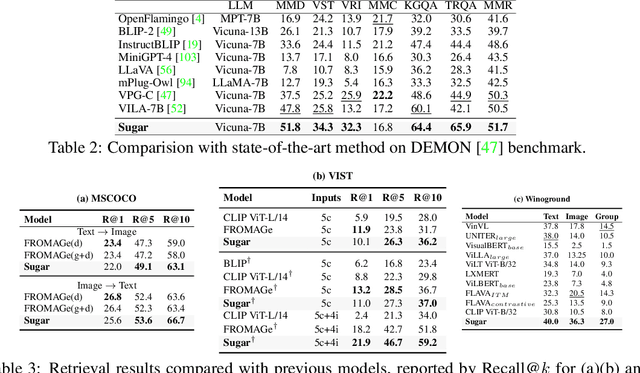
Abstract:In recent times, Vision-Language Models (VLMs) have been trained under two predominant paradigms. Generative training has enabled Multimodal Large Language Models (MLLMs) to tackle various complex tasks, yet issues such as hallucinations and weak object discrimination persist. Discriminative training, exemplified by models like CLIP, excels in zero-shot image-text classification and retrieval, yet struggles with complex scenarios requiring fine-grained semantic differentiation. This paper addresses these challenges by proposing a unified approach that integrates the strengths of both paradigms. Considering interleaved image-text sequences as the general format of input samples, we introduce a structure-induced training strategy that imposes semantic relationships between input samples and the MLLM's hidden state. This approach enhances the MLLM's ability to capture global semantics and distinguish fine-grained semantics. By leveraging dynamic sequence alignment within the Dynamic Time Warping framework and integrating a novel kernel for fine-grained semantic differentiation, our method effectively balances generative and discriminative tasks. Extensive experiments demonstrate the effectiveness of our approach, achieving state-of-the-art results in multiple generative tasks, especially those requiring cognitive and discrimination abilities. Additionally, our method surpasses discriminative benchmarks in interleaved and fine-grained retrieval tasks. By employing a retrieval-augmented generation strategy, our approach further enhances performance in some generative tasks within one model, offering a promising direction for future research in vision-language modeling.
Reverse Modeling in Large Language Models
Oct 13, 2024



Abstract:Humans are accustomed to reading and writing in a forward manner, and this natural bias extends to text understanding in auto-regressive large language models (LLMs). This paper investigates whether LLMs, like humans, struggle with reverse modeling, specifically with reversed text inputs. We found that publicly available pre-trained LLMs cannot understand such inputs. However, LLMs trained from scratch with both forward and reverse texts can understand them equally well during inference. Our case study shows that different-content texts result in different losses if input (to LLMs) in different directions -- some get lower losses for forward while some for reverse. This leads us to a simple and nice solution for data selection based on the loss differences between forward and reverse directions. Using our selected data in continued pretraining can boost LLMs' performance by a large margin across different language understanding benchmarks.
Towards Natural Image Matting in the Wild via Real-Scenario Prior
Oct 09, 2024



Abstract:Recent approaches attempt to adapt powerful interactive segmentation models, such as SAM, to interactive matting and fine-tune the models based on synthetic matting datasets. However, models trained on synthetic data fail to generalize to complex and occlusion scenes. We address this challenge by proposing a new matting dataset based on the COCO dataset, namely COCO-Matting. Specifically, the construction of our COCO-Matting includes accessory fusion and mask-to-matte, which selects real-world complex images from COCO and converts semantic segmentation masks to matting labels. The built COCO-Matting comprises an extensive collection of 38,251 human instance-level alpha mattes in complex natural scenarios. Furthermore, existing SAM-based matting methods extract intermediate features and masks from a frozen SAM and only train a lightweight matting decoder by end-to-end matting losses, which do not fully exploit the potential of the pre-trained SAM. Thus, we propose SEMat which revamps the network architecture and training objectives. For network architecture, the proposed feature-aligned transformer learns to extract fine-grained edge and transparency features. The proposed matte-aligned decoder aims to segment matting-specific objects and convert coarse masks into high-precision mattes. For training objectives, the proposed regularization and trimap loss aim to retain the prior from the pre-trained model and push the matting logits extracted from the mask decoder to contain trimap-based semantic information. Extensive experiments across seven diverse datasets demonstrate the superior performance of our method, proving its efficacy in interactive natural image matting. We open-source our code, models, and dataset at https://github.com/XiaRho/SEMat.
Frame-Voyager: Learning to Query Frames for Video Large Language Models
Oct 07, 2024Abstract:Video Large Language Models (Video-LLMs) have made remarkable progress in video understanding tasks. However, they are constrained by the maximum length of input tokens, making it impractical to input entire videos. Existing frame selection approaches, such as uniform frame sampling and text-frame retrieval, fail to account for the information density variations in the videos or the complex instructions in the tasks, leading to sub-optimal performance. In this paper, we propose Frame-Voyager that learns to query informative frame combinations, based on the given textual queries in the task. To train Frame-Voyager, we introduce a new data collection and labeling pipeline, by ranking frame combinations using a pre-trained Video-LLM. Given a video of M frames, we traverse its T-frame combinations, feed them into a Video-LLM, and rank them based on Video-LLM's prediction losses. Using this ranking as supervision, we train Frame-Voyager to query the frame combinations with lower losses. In experiments, we evaluate Frame-Voyager on four Video Question Answering benchmarks by plugging it into two different Video-LLMs. The experimental results demonstrate that Frame-Voyager achieves impressive results in all settings, highlighting its potential as a plug-and-play solution for Video-LLMs.
Learning De-Biased Representations for Remote-Sensing Imagery
Oct 06, 2024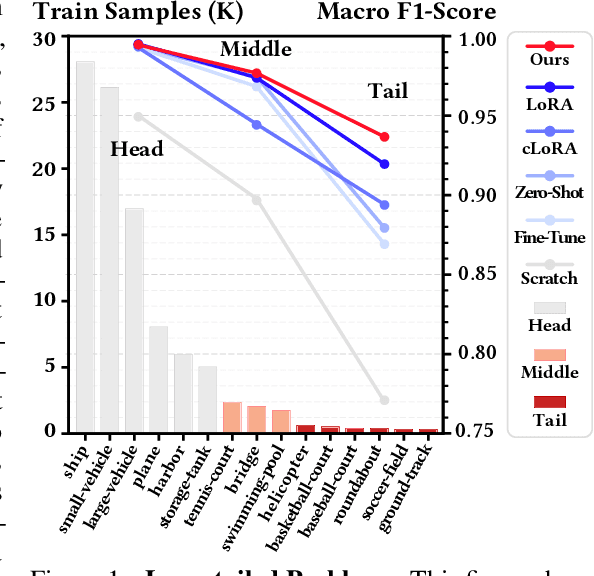
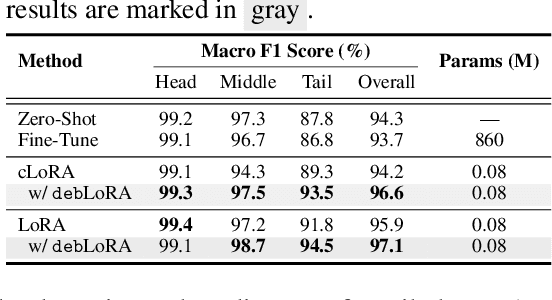

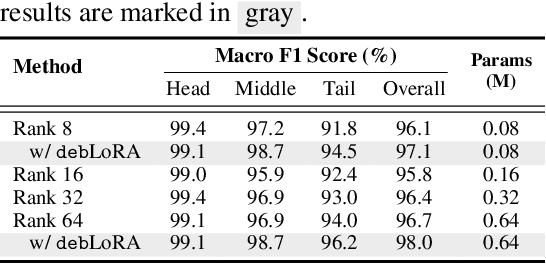
Abstract:Remote sensing (RS) imagery, requiring specialized satellites to collect and being difficult to annotate, suffers from data scarcity and class imbalance in certain spectrums. Due to data scarcity, training any large-scale RS models from scratch is unrealistic, and the alternative is to transfer pre-trained models by fine-tuning or a more data-efficient method LoRA. Due to class imbalance, transferred models exhibit strong bias, where features of the major class dominate over those of the minor class. In this paper, we propose debLoRA, a generic training approach that works with any LoRA variants to yield debiased features. It is an unsupervised learning approach that can diversify minor class features based on the shared attributes with major classes, where the attributes are obtained by a simple step of clustering. To evaluate it, we conduct extensive experiments in two transfer learning scenarios in the RS domain: from natural to optical RS images, and from optical RS to multi-spectrum RS images. We perform object classification and oriented object detection tasks on the optical RS dataset DOTA and the SAR dataset FUSRS. Results show that our debLoRA consistently surpasses prior arts across these RS adaptation settings, yielding up to 3.3 and 4.7 percentage points gains on the tail classes for natural to optical RS and optical RS to multi-spectrum RS adaptations, respectively, while preserving the performance on head classes, substantiating its efficacy and adaptability.
Towards Unified Multimodal Editing with Enhanced Knowledge Collaboration
Sep 30, 2024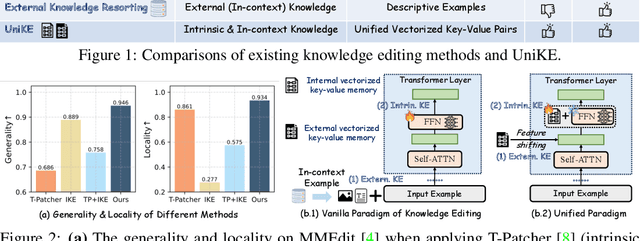
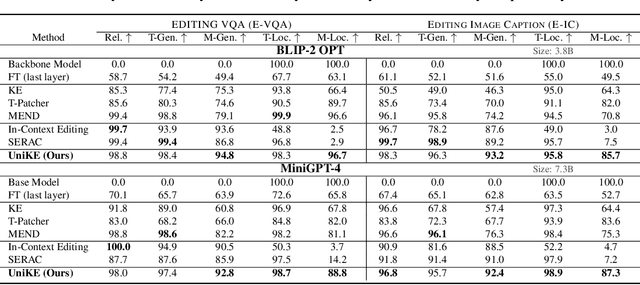
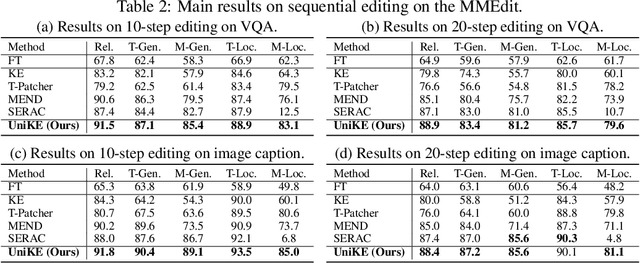
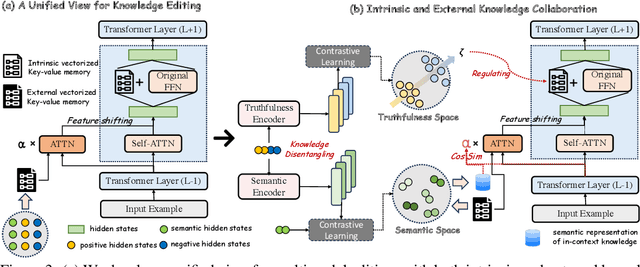
Abstract:The swift advancement in Multimodal LLMs (MLLMs) also presents significant challenges for effective knowledge editing. Current methods, including intrinsic knowledge editing and external knowledge resorting, each possess strengths and weaknesses, struggling to balance the desired properties of reliability, generality, and locality when applied to MLLMs. In this paper, we propose UniKE, a novel multimodal editing method that establishes a unified perspective and paradigm for intrinsic knowledge editing and external knowledge resorting. Both types of knowledge are conceptualized as vectorized key-value memories, with the corresponding editing processes resembling the assimilation and accommodation phases of human cognition, conducted at the same semantic levels. Within such a unified framework, we further promote knowledge collaboration by disentangling the knowledge representations into the semantic and truthfulness spaces. Extensive experiments validate the effectiveness of our method, which ensures that the post-edit MLLM simultaneously maintains excellent reliability, generality, and locality. The code for UniKE will be available at \url{https://github.com/beepkh/UniKE}.
 Add to Chrome
Add to Chrome Add to Firefox
Add to Firefox Add to Edge
Add to Edge